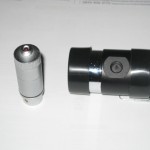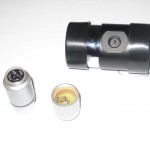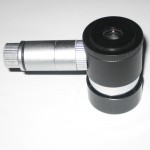When imaging with the 127 Mak and SPC900, getting the target somewhere the webcam will pick it up is one of the most awkward things to do. It’s made more tricky by the fact that if the scope is sufficiently far from focus then there won’t be a discernable image on the webcam to start with.
My previous solution to this problem has been to start with a 32mm eyepiece, centre the target and then run up through a range of eyepieces (25mm, 15mm, 9mm, 6mm) checking that the object is still in the centre and realigning as necessary before dropping the webcam in. At that point I turn the gain and brightness full up in the capture program and hopefully I can see something resembling a fuzzy blob on the screen that allows me to adjust the focus.
For some time I’ve been thinking about getting an eyepiece with an illuminated reticle to allow me to short-cut this process, but I’ve been put off by the prices. I discovered last week however that Sky’s the Limit who I’ve used for kit in the past had just such an eyepiece with a 12.5mm focal length going for less than £40 so I thought it would be worth a try. Here it is:
 |
 |
 |
The LED is powered by two GP189 batteries (included). The knurled knob at the end of the LED unit turns it on and controls the brightness. There’s also a knurled adjuster on the top of the eyepiece. This is used to get the reticle lines in focus, but it does also change the point of focus of the telescope at the same time.
I’ve had a very quick test this evening looking at Mars and am happy that it does what it says on the tin. Unfortunately cloud prevented me from trying it out a bit more. What was quite surprising was how fast the image of Mars crosses the field of view at 120x magnification. I’m used to it happening, but somehow it seems far more obvious when you have some sort of visual reference.
I look forward to trying it out properly in my next imaging session. The only down-side is that I’ve run out of room in my eyepiece case…
